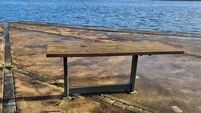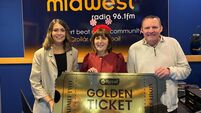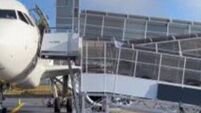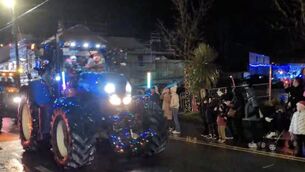Dawn walk to historic County Roscommon pilgrim site connects past and present
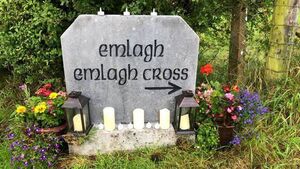
The new signs pointing to Emlagh Cross, an historic pilgrim site.
Over 200 people last week completed a dawn pilgrim walk to the historic pilgrim site, Emlagh Cross outside Castlerea, as part of the jubilee year of Pilgrims of Hope.
The Emlagh site is regarded among archaeologists and academics as one of the most important pilgrim sites in the country, featuring an array of historical features and attributes such as the remains of an ancient Celtic High Cross, a ‘Cillin’ which is a type of ancient children’s burial ground and a Holy Well.
Marie Stenson a member of Castlerea Pastoral Parish Council (CPPC) extended a Ceád Míle Fáilte and Fr. John McManus, Parish Priest, had a special blessing before they set off on the pilgrim walk.
Paddy Egan, a native of Emlagh, who has walked 57 times from Castlerea to Knock Shrine, led the way with three reflection stops along the route. The first reflection stop was at the Demesne gates where Pat O’Connor remembered all who supported those on their own journeys. At upper Longford, on the hill, the second reflection was led by Marie Stenson who focused on burdens we all carry. The third and final reflection spot was at the head of the road leading into Emlagh Cross where Marie Stenson read a piece on peace.
As the pilgrims approached the entrance to Emlagh ecclesiastical and heritage site Terry McGowan played the flute while Fr. Kevin Reynolds met with pilgrims as they made their way into the sacred space.
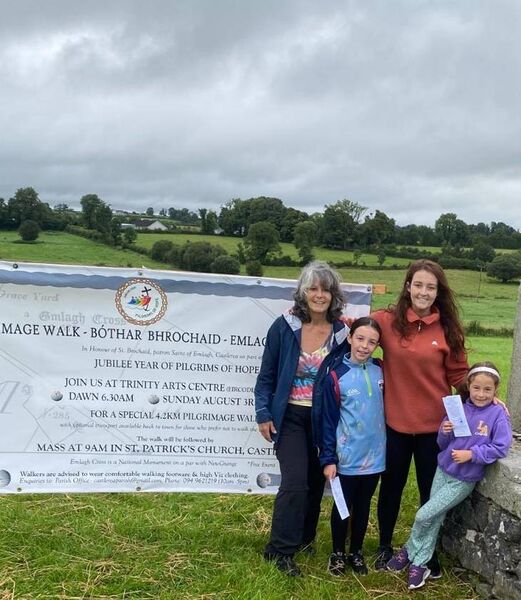
A member of CRHAS and Craobh de hÍde and a cornerstone of the pilgrimage, Mary O’Connell read the opening prayer at Emlagh Cross, and later led part of the gathering to the Cillín where she shared informative and thought provoking words about the special burial ground dating back to medieval times up to the early mid 20th century.
At the Celtic High Cross, Jacinta Greene Beatty read a prayer, connecting past and present, which was written by Fr.Kevin Reynolds. Terry Mc Gowan accompanied on flute.
Edmund Hester a member of CRHAS shared folklore with pilgrims at the holy well. Before pilgrims left the sacred space they received a special ‘Bóthar Bhrochaid’ pilgrim stamp on their guide books and they also gathered around a large table and signed their names in blue, green, red and yellow colours on the pilgrim of hope flag. A painting by Frances Morris of Emlagh High Cross formed the cover page of the mass booklets and pilgrims’ guides, which is a very special family connection with Emlagh’s past and present.
The name Emlagh itself comes from the Irish ‘Imleach Each,’ the marsh of the horses or the edge of the marsh of the horses. The link to the marsh is explained by the fact that there was once a lake near the site, which has long since dried up.
Situated on the southeastern side of Castlerea, off the R377 Castlerea to Ballintubber road, Emlagh Cross is an ancient monument built in approximately 1015 AD at the entrance to the church of St Brochaid.
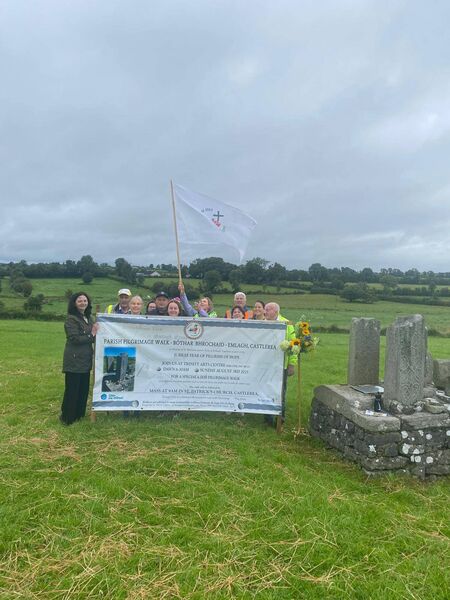
It has been designated a National Monument in State guardianship, the highest designation possible.
It’s understood the church on the Emlagh site itself was founded by St Patrick between approximately 433 to 434 AD and placed under the administration of St Brochaid, said to be a nephew of St Patrick. St Brochaid’s mother was called Tigris, reputed to be a sister of St Patrick.
The site is located in a field owned by local man, Seamus Morris and has been in the Morris family for generations. There are six large pieces of the cross remaining on the site, despite historical damage.
The church was destroyed and the cross was damaged in the year 1537, as the Reformation intensified in ferocity and Catholic churches and ecclesiastical properties were destroyed throughout the country.
Today the Emlagh site has three notable historical features including St. Brochaid’s High Cross, which dates to 1015 when it was made and erected at the entrance to the church. Part of the devotion at the nearby holy well was the drinking of the water, and the removal of the water to wash disease affected areas of the body.
The sacred landscape for the pilgrim walk was prepared by Seamus Morris, Joe Mulligan, Liam Morris, Michael Neary, Paddy Egan, Marion Bruen, Eoin Beatty and Edmund Hestor. Michael Carney’s hand crafted limestone scallop, which is the symbol of pilgrimage, caught the attention of pilgrims, as they entered the site.
Rural Recreational Officer with Roscommon Leader Partnership Kyle Flynn marked the route earlier in the week and organised and erected a new information board for Bóthar Bhrochaid outside Trinity Arts Centre.
Adrian Gorman, Roscommon County Council and Seán Tarmey collaborated with the committee to ensure hedging was trimmed to allow the large crowd to make their way safely along the route.
Cllr Michael Holland organised and sponsored signage to Emlagh High Cross, which was erected at Lisliddy Cross Roads in time for the event. Members of Castlerea Town Team, Cllr Pascal Fitzmaurice, Susan Gaynor and Breege Callaghan, assisted the organising committee with the event which coincided with the Castlerea Rose Festival.
Thanks to Castlerea Town Team who organised the return transport for pilgrims with Garda Tanya Duffy. Míle buíochas to Olivia and Leanne Vaughan who tailed the pilgrims by car with Olivia available to provide medical assistance if needed. A huge thanks also to Austin Waldron who captured the moments on camera and to marshals Liam Morris, Darragh Kelly, Richard Finan, Mat Griffith, and Stephen Doherty who made sure everyone returned home safely.
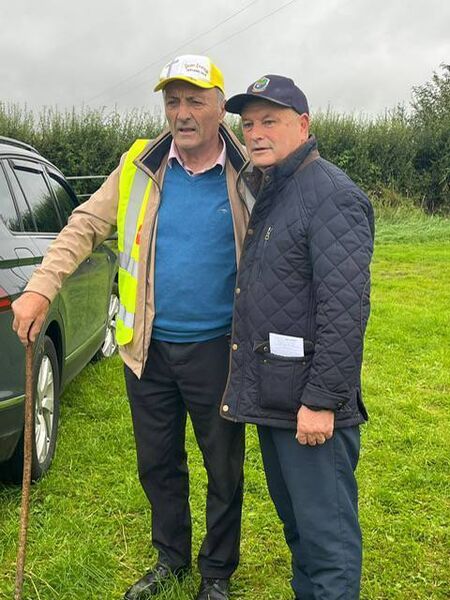
A special word of thanks to Harry Keegan, a well decorated Roscommon footballer with three all-stars and strong family connections with Emlagh who was a great ambassador for the project. Thanks to his brother Tommy Keegan, Seamus Morris, Mary O’Connell, and John Joe Connell who took part in promotional clips recorded in Emlagh.
Gratitude to all those who took part in the pilgrimage and who set up altars, flowers, candles, lanterns, flags and buntings outside their homes, which all added to the pilgrimage experience. To all who attended the pilgrimage, including members from ICA Castlerea branch, members of Castlerea choir, members of Castlerea Brass Band, members of County Roscommon Historical and Archaeological Society (CRHAS ), members of Castlerea Crusaders Athletics Club, members of Craobh de hÍde (a registered branch of Conradh na Gaeilge), members of Castlerea Parish Pastoral Council with neighbours family and friends of Emlagh and indeed Castlerea.
Also sincere thanks to the 40 American archaeological students and their lecturers Niall Brady and Andrew Blair from the ‘Castles in Community Project’ in Ballintubber who did their pilgrimage on July 25th and walked Slí Gleanna na tSúca and to Lucy DeMeo who prayed a prayer of the faithful at the Mass of Remembrance. Go raibh míle maith agaibh.
Custodians Seamus Morris and Joe Mulligan deserve huge credit for their generosity in allowing events to take place on their lands and who facilitated the organising committee in every way possible. The pilgrimage events were funded and insured through Conradh na Gaeilge. Also thanks to Gillian McGarry, tourism activator Roscommon County Council, who supported the launch on July 25th.
Many pilgrims made their way back to St.Patrick’s Church for 9 a.m. Mass where Fr. Kevin prayed for all those who took part in the pilgrimage events which he described as ‘life giving’.
Terry McGowan played the flute during Mass. It was a special day for Terry and Pauline on a personal level as they celebrated their 34th wedding anniversary by welcoming pilgrims to Emlagh.
